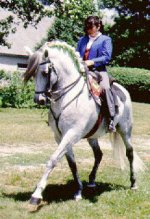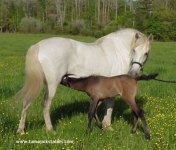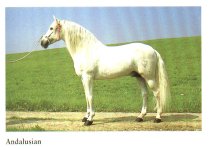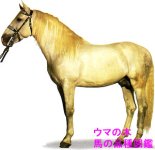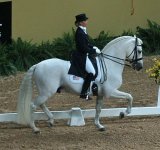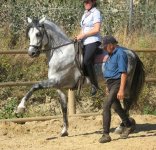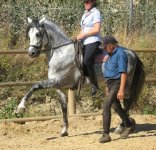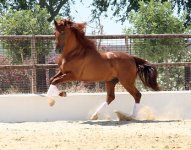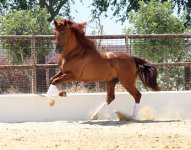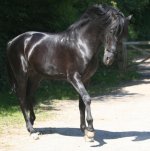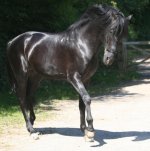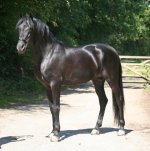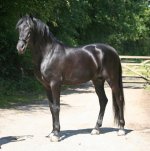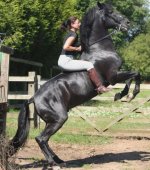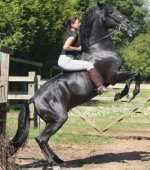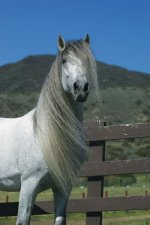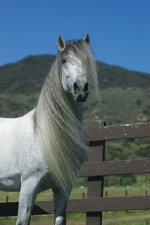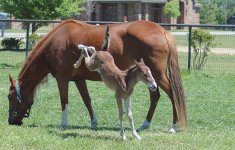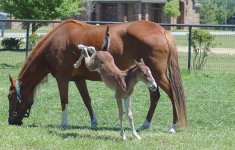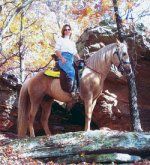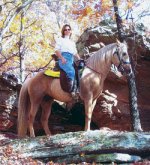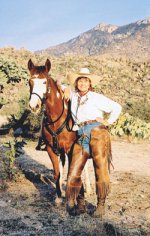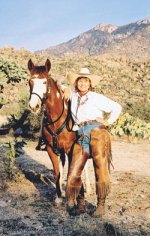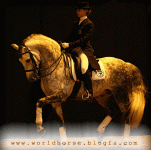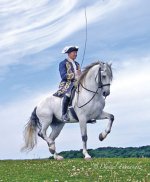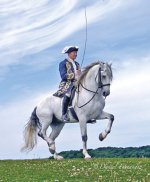♘امیرحسین♞
♘ مدیریت انجمن اسب ایران ♞
Andalusian horse or Spanish horse
The Andalusian horse or Spanish horse is one of the oldest breeds of horses in the world today. It is also known as the PRE (Pura Raza Española; in English, Pure Spanish-bred) in most countries because of the work done by the Spanish studbook in promoting the pure bred horses around the world. It is one of the two sub-breeds of the Iberian horses, and extremely similar to the closely related Lusitano breed.
Andalusians have been used for all manner of riding horses, and were the preferred mount of kings over many centuries. They excel in high school dressage and are used in cattle work and bullfighting in their native Spain. They are highly intelligent and learn very quickly.
Partbred Andalusians are popular as sport horses in many countries. They also excel at classical dressage and are used for show jumping and other equestrian activities.
Distinguishing
Strongly-built, compact,
features:
15.2-16.2 hands. High, elegant action, medium-length head with convex profile, large eyes, long broad neck, powerful musculature, thick mane and tail.
Alternative
Spanish Horse, Pura Raza
names:
Española
Country of origin:
Spain, Iberian Peninsula
History of the breed
Archaeological evidence in the Iberian Peninsula, modern day Spain and Portugal, indicates that the origins of the Iberian Horse date back to at least 25,000 B.C. in the form of its primitive ancestor, the Sorraia. Cave paintings in the Iberian Peninsula dated from around 20,000 BC depict portraits of horses and activities related to a horse culture.
The Sorraia horse remained isolated for several millennia in the southern part of Iberia, the Alentejo and Andalusian regions of modern Portugal and Spain. Portuguese historian Ruy d'Andrade suggested that by the Neolithic period (4000 B.C.) the native tribes of the area may have used horses in war.
They were soon to be followed by Phoenician traders and Celts from northern and eastern Europe, who were largely responsible for a two-way exchange of horses which brought an influx of oriental breeds from Libya, Egypt and Syria to the Iberian peninsula. By the time of the first trading expeditions of the Greeks, around 900 B.C., a mixed Celtiberian culture dominated all of Spain apart from the south coast, which remained Iberian. According to Lady Sylvia Loch, "It was the horses of the Celtiberian that were to become famous throughout the civilized world."
The Spanish horses were known for their use as cavalry mounts by the Ancient Greeks and Romans.
From this period onward, we find many references to the Iberian or Celtiberian horses and riders of the peninsula by Greek and Roman chroniclers. Homer refers to them in the Iliad around 1,100 B.C. and the celebrated Greek cavalry officer Xenophon had nothing but praise for the gifted Iberian horses and horsemen. Xenophon, in one of his books written about 370 B.C., admiringly describes the equestrian war techniques of Iberian mercenaries who were influential in the victory of Sparta against Athens in the Peloponnesian wars. This type of warfare consisted of individual horse charges with fast starts, stops and pirouettes followed by retreats and renewed attacks. A form of riding that was made possible by the use of incredibly agile horses and curb bits.
Fine Spanish horses were brought into Britain after the Norman Conquest, however. In 1188 the chronicler Giraldus Cambrensis noted in Powys
"most excellent studs put apart for breeding, and deriving their origin from some fine Spanish horses, which Robert de Belesme, earl of Shrewsbury, brought into this country: on which account the horses sent from hence are remarkable for their majestic proportion and astonishing fleetness."[1]
Later, the use of heavy plate armor required stronger breeds. In the 15th century, the invention of firearms called for a lighter, and more agile cavalry horse, and the Andalusian's popularity rose again.
During the Renaissance, the great Classical Riding Academies took an interest in the breed. Because of the Andalusian's agility and natural balance, it excelled in the High School Dressage performed in many courts of the day. The Andalusian went on to develop many other breeds suitable for High School Dressage, including the Lipizzan, Alter Real, Lusitano, Kladruber, and many European warmbloods of today.
During the 19th century, the use of the Andalusian declined. However, Carthusian monks continued to breed the horse, and preserved the purity. Today, the Spanish government promotes the Andalusian, and the breed is gaining in popularity for High School Dressage demonstrations. They are also popular for bullfighting, and have recently been used for dressage, show jumping, driving and endurance, although Thoroughbred blood is often added to give the breed more scope.
Breed Characteristics
Andalusians are strongly-built, compact horses, generally standing 15.2-16.2 hands. They move with a high, elegant action, which makes them particularly suitable for Haute École (or High School) Dressage. They usually have a lean, medium-length head with a convex profile and large eyes, a long but broad and sometimes cresty neck (particularly in stallions), a long, sloping shoulder, clean legs with good bone, short, strong cannons, and a thick, long, flowing mane and tail. The Andalusian has a reputation for a proud but cooperative temperament, sensitive and intelligent, able to learn quickly and easily when treated with respect and care.
Andalusian horses today are found in a number of colours although the most common colour, seen in about 80% of all Andalusians, is grey. There are also purebreds who are bay, black, and chestnut. Other colours, such as palomino, are not recognized as a legal colour for Andalusians in most countries, as the presence of the dilution gene that creates the colour is considered evidence of crossbreeding. However these colours are recognized in the Lusitano breed of Portugal, descended from the Andalusian horse.
Andalusians have been used for all manner of riding horses, and were the preferred mount of kings over many centuries. They excel in high school dressage and are used in cattle work and bullfighting in their native Spain. They are highly intelligent and learn very quickly.
Partbred Andalusians are popular as sport horses in many countries. They also excel at classical dressage and are used for show jumping and other equestrian activities.
Distinguishing
Strongly-built, compact,
features:
15.2-16.2 hands. High, elegant action, medium-length head with convex profile, large eyes, long broad neck, powerful musculature, thick mane and tail.
Alternative
Spanish Horse, Pura Raza
names:
Española
Country of origin:
Spain, Iberian Peninsula
History of the breed
Archaeological evidence in the Iberian Peninsula, modern day Spain and Portugal, indicates that the origins of the Iberian Horse date back to at least 25,000 B.C. in the form of its primitive ancestor, the Sorraia. Cave paintings in the Iberian Peninsula dated from around 20,000 BC depict portraits of horses and activities related to a horse culture.
The Sorraia horse remained isolated for several millennia in the southern part of Iberia, the Alentejo and Andalusian regions of modern Portugal and Spain. Portuguese historian Ruy d'Andrade suggested that by the Neolithic period (4000 B.C.) the native tribes of the area may have used horses in war.
They were soon to be followed by Phoenician traders and Celts from northern and eastern Europe, who were largely responsible for a two-way exchange of horses which brought an influx of oriental breeds from Libya, Egypt and Syria to the Iberian peninsula. By the time of the first trading expeditions of the Greeks, around 900 B.C., a mixed Celtiberian culture dominated all of Spain apart from the south coast, which remained Iberian. According to Lady Sylvia Loch, "It was the horses of the Celtiberian that were to become famous throughout the civilized world."
The Spanish horses were known for their use as cavalry mounts by the Ancient Greeks and Romans.
From this period onward, we find many references to the Iberian or Celtiberian horses and riders of the peninsula by Greek and Roman chroniclers. Homer refers to them in the Iliad around 1,100 B.C. and the celebrated Greek cavalry officer Xenophon had nothing but praise for the gifted Iberian horses and horsemen. Xenophon, in one of his books written about 370 B.C., admiringly describes the equestrian war techniques of Iberian mercenaries who were influential in the victory of Sparta against Athens in the Peloponnesian wars. This type of warfare consisted of individual horse charges with fast starts, stops and pirouettes followed by retreats and renewed attacks. A form of riding that was made possible by the use of incredibly agile horses and curb bits.
Fine Spanish horses were brought into Britain after the Norman Conquest, however. In 1188 the chronicler Giraldus Cambrensis noted in Powys
"most excellent studs put apart for breeding, and deriving their origin from some fine Spanish horses, which Robert de Belesme, earl of Shrewsbury, brought into this country: on which account the horses sent from hence are remarkable for their majestic proportion and astonishing fleetness."[1]
Later, the use of heavy plate armor required stronger breeds. In the 15th century, the invention of firearms called for a lighter, and more agile cavalry horse, and the Andalusian's popularity rose again.
During the Renaissance, the great Classical Riding Academies took an interest in the breed. Because of the Andalusian's agility and natural balance, it excelled in the High School Dressage performed in many courts of the day. The Andalusian went on to develop many other breeds suitable for High School Dressage, including the Lipizzan, Alter Real, Lusitano, Kladruber, and many European warmbloods of today.
During the 19th century, the use of the Andalusian declined. However, Carthusian monks continued to breed the horse, and preserved the purity. Today, the Spanish government promotes the Andalusian, and the breed is gaining in popularity for High School Dressage demonstrations. They are also popular for bullfighting, and have recently been used for dressage, show jumping, driving and endurance, although Thoroughbred blood is often added to give the breed more scope.
Breed Characteristics
Andalusians are strongly-built, compact horses, generally standing 15.2-16.2 hands. They move with a high, elegant action, which makes them particularly suitable for Haute École (or High School) Dressage. They usually have a lean, medium-length head with a convex profile and large eyes, a long but broad and sometimes cresty neck (particularly in stallions), a long, sloping shoulder, clean legs with good bone, short, strong cannons, and a thick, long, flowing mane and tail. The Andalusian has a reputation for a proud but cooperative temperament, sensitive and intelligent, able to learn quickly and easily when treated with respect and care.
Andalusian horses today are found in a number of colours although the most common colour, seen in about 80% of all Andalusians, is grey. There are also purebreds who are bay, black, and chestnut. Other colours, such as palomino, are not recognized as a legal colour for Andalusians in most countries, as the presence of the dilution gene that creates the colour is considered evidence of crossbreeding. However these colours are recognized in the Lusitano breed of Portugal, descended from the Andalusian horse.

